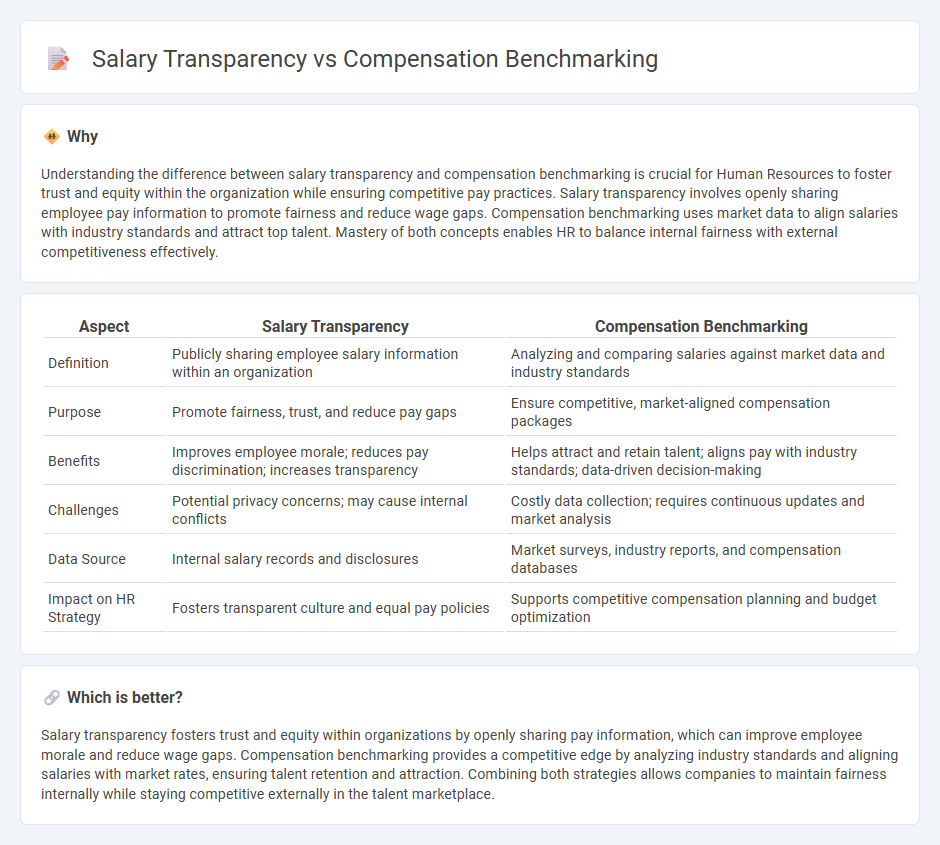
Salary transparency fosters trust and equity by openly sharing employee pay information within organizations, promoting fairness and reducing wage gaps. Compensation benchmarking involves analyzing market salaries and industry standards to ensure competitive and aligned pay structures. Explore how these strategies impact talent retention and organizational culture.
Why it is important
Understanding the difference between salary transparency and compensation benchmarking is crucial for Human Resources to foster trust and equity within the organization while ensuring competitive pay practices. Salary transparency involves openly sharing employee pay information to promote fairness and reduce wage gaps. Compensation benchmarking uses market data to align salaries with industry standards and attract top talent. Mastery of both concepts enables HR to balance internal fairness with external competitiveness effectively.
Comparison Table
| Aspect | Salary Transparency | Compensation Benchmarking |
|---|---|---|
| Definition | Publicly sharing employee salary information within an organization | Analyzing and comparing salaries against market data and industry standards |
| Purpose | Promote fairness, trust, and reduce pay gaps | Ensure competitive, market-aligned compensation packages |
| Benefits | Improves employee morale; reduces pay discrimination; increases transparency | Helps attract and retain talent; aligns pay with industry standards; data-driven decision-making |
| Challenges | Potential privacy concerns; may cause internal conflicts | Costly data collection; requires continuous updates and market analysis |
| Data Source | Internal salary records and disclosures | Market surveys, industry reports, and compensation databases |
| Impact on HR Strategy | Fosters transparent culture and equal pay policies | Supports competitive compensation planning and budget optimization |
Which is better?
Salary transparency fosters trust and equity within organizations by openly sharing pay information, which can improve employee morale and reduce wage gaps. Compensation benchmarking provides a competitive edge by analyzing industry standards and aligning salaries with market rates, ensuring talent retention and attraction. Combining both strategies allows companies to maintain fairness internally while staying competitive externally in the talent marketplace.
Connection
Salary transparency fosters trust and equity within organizations by openly sharing pay information, which directly influences compensation benchmarking practices that analyze market data to set competitive and fair salary structures. Compensation benchmarking relies on transparent salary data to accurately compare internal pay scales against external market rates, ensuring alignment with industry standards and enhancing employee satisfaction. Both concepts work synergistically to promote organizational fairness, improve talent retention, and support strategic human resources planning.
Key Terms
Market Rate
Compensation benchmarking involves analyzing market rate data to set competitive salary levels that attract and retain talent. Salary transparency promotes open communication about pay structures, fostering trust and equity but relies on accurate benchmark data to be effective. Explore how aligning benchmarking with transparency strategies can optimize workforce management.
Pay Equity
Compensation benchmarking involves analyzing market salary data to ensure competitive and equitable pay structures within organizations, while salary transparency promotes openness by sharing pay information among employees to reduce wage gaps. Both strategies aim to address pay equity by mitigating biases and fostering fair compensation practices. Explore how integrating benchmarking and transparency can drive meaningful progress in workplace pay equity.
Internal Communication
Compensation benchmarking utilizes market data to align employee salaries competitively, ensuring internal equity and external relevance. Salary transparency promotes trust and reduces pay disparities by openly sharing compensation structures within the organization. Explore more strategies to enhance internal communication and employee satisfaction.
Source and External Links
Salary Benchmarking: Steps, Best Practices, and Tips - NetSuite - Compensation benchmarking is the process of comparing salaries and benefits among organizations by defining roles and matching them to peer companies, influenced by factors like industry, location, economic conditions, and company size.
Salary Benchmarking for Startups - Compensation - Carta - Effective compensation benchmarking involves setting compensation philosophies, defining roles clearly, collecting reliable market data, establishing salary bands, and maintaining transparent communication to build trust and ensure fairness.
Compensation 101: establishing a benchmark methodology - A salary benchmarking methodology is a structured framework that ensures consistent and accurate market pricing by matching jobs internally to external market data and clustering jobs into pay ranges reflecting their market and internal value.
 dowidth.com
dowidth.com